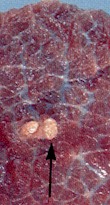Beef Tapeworm Location on a Map
Cysticercus bovis is the larval phase (cysticercoid, metacestode) of Taenia saginata , a homo tapeworm parasite, that has cattle, buffaloes, llamas, and various wild ruminants equally intermediate hosts.
Cysticercus bovis occurs worldwide, mainly in poorly developed rural regions with insufficient germ-free weather condition.
The disease caused by this and other cysticercoids is chosen cysticercosis. In this particular case it is as well called beef measles.

Cysticercus bovis does not impact dogs, cats, horses, sheep, goats, swine or poultry.
Is livestock infected with Cysticercus bovis contagious for humans?
YES . Humans can get infected with Taenia saginata tapeworms subsequently eating uncooked meat or other tissues from infected cattle or buffaloes. Uncomplicated contact with the creature or its feces is not contagious. See the life cycle below.
Yous tin can find additional information in this site on the general biological science of parasitic worms and/or tapeworms.
Last location of Cysticercus bovis
Cysticercoids of Taenia saginata are found mainly in the muscles of cattle and buffaloes. The predilection site of adult tapeworms in their human hosts is the small intestine.
Beefcakeof Cysticercus bovis
In cattle Cysticercus ovis appears as small-scale whitish cysts filled with fluid that contain an immature worm. They have the size of a pea (v to 8 mm). Infected beef can have dozens of such cysts. They are plant mainly in the muscles of the heart, the diaphragm, the tongue, and the jaws. Several months afterwards infection the cysts die and get calcified.
Visit the page on Taenia species for additional data of the anatomy of developed Taenia tapeworms.
Life bike and biology of Cysticercus bovis
As all tapeworms, Taenia saginata has an indirect life cycle, with humans every bit terminal hosts, and cattle, buffaloes and other bovids as intermediate hosts.
Cattle become infested when ingesting food or water contaminated with eggs or gravid segments of Taenia saginata. Contagion of cattle feed can occur through undue defecation of humans in the pastures or stables, just also indirectly through irrigation with contaminated man sewage. The eggs tin remain infective for more than six months.
One time ingested by cattle the young larvae hatch out of the eggs in the gut, become through the intestinal wall, reach the blood stream and migrate to a muscle, where they encyst. The cysts demand 10 to 12 weeks to complete development. The cysts may remain infective for humans for upward to one year.
Humans become infected when eating comparatively cooked meat contaminated with cysts. Once in the human gut, the cysts release the young tapeworm, which attach to the gut's wall and start producing segments. Within 5 to 12 weeks the tapeworms mature and kickoff shedding eggs (prepatent period).
Harm acquired past Cysticercus bovis, symptoms and diagnosis
Cysticercus bovis is not pathogenic for cattle and usually the infection causes no clinical signs, unless a vital organ (e.g. the heart) is massively infected, which is very unsusual. In instance of massive infections musculus stiffness has been reported. However, infections have a substantial economic impact because the whole carcass is condemned at slaughter. This is needed to forestall that humans become infected when consuming beefiness insufficiently cooked.
So far diagnosis on cattle is just possible post-mortem after carcass examination.
Homo infections with Taenia saginata are ordinarily benign. They tin cause diarrhea and loss of appetite, but they ofttimes cause no clinical signs.
Prevention and control ofCysticercus bovis
Although beef measles is not harmful for cattle, prevention is important to avoid transmission to humans and carcass condemnation at slaughter.
Best prevention consists in avoiding the contamination of cattle feed (fresh pasture equally well as hay and silage, etc.) or water with human feces that may contain tapeworm eggs. This requires providing acceptable latrines for workers and ensuring that sewage water used for pasture irrigation is not contaminated. It must exist considered that the eggs may remain infective in the feed after silage or other processing of hey or fodder (pelletizing, fermentation, etc.).
The regular use of anthelmintics is commonly not indicated to forbid cattle infections with Cysticercus bovis. At that place are reports that albendazole, ricobendazole and praziquantel, are effective, just often at dose significantly higher than the therapeutic one, and results can be unreliable.
Several classic livestock anthelmintics such as macrocyclic lactones (due east.yard. ivermectin, selamectin, etc.), levamisole, tetrahydropyrimidines (e.g. pyrantel, morantel) and piperazine derivatives are non effective at all against Cysticercus bovis or whatever developed tapeworm or cysticercoid.
There are and then far no vaccines that would protect cattle confronting Cysticercus bovis. A lot of inquiry is being done in the development of a vaccine against beef measles, but so far there are no commercial vaccines in most countries.To learn more than virtually vaccines against parasites of livestock and pets click here.
Biological control of Taenia tapeworms respectively Cysticercus bovis (i.east. using its natural enemies) is so far not feasible.
Y'all may be interested in an article in this site on medicinal plants against external and internal parasites.
Resistance of Taenia spp to anthelmintics
So far there are no reports on resistance of Taenia spp, respectively Cysticercus bovis to anthelmintics.
This means that if aa anthelmintic flukicide fails to attain the expected efficacy, adventure is very high that it is non due to resistance. Either the product was used incorrectly or it was unsuited for the control of these parasites. Wrong employ is the near frequent reason for failure of antiparasitic drugs.
Inquire your veterinarian doctor! If bachelor, follow more specific national or regional recommendations for Cysticercus bovis control.
Source: https://parasitipedia.net/index.php?option=com_content&view=article&id=2578&Itemid=2860
0 Response to "Beef Tapeworm Location on a Map"
Enviar um comentário